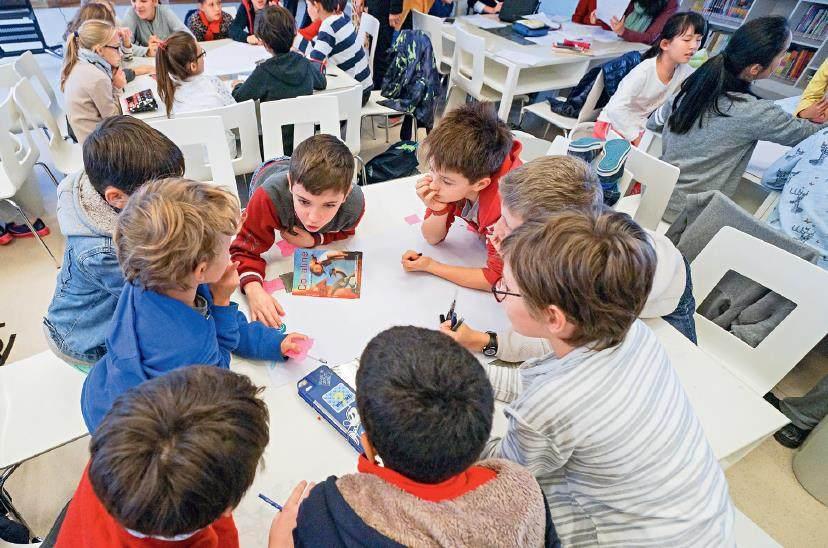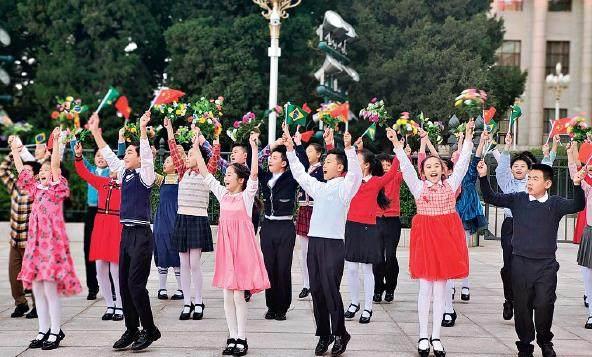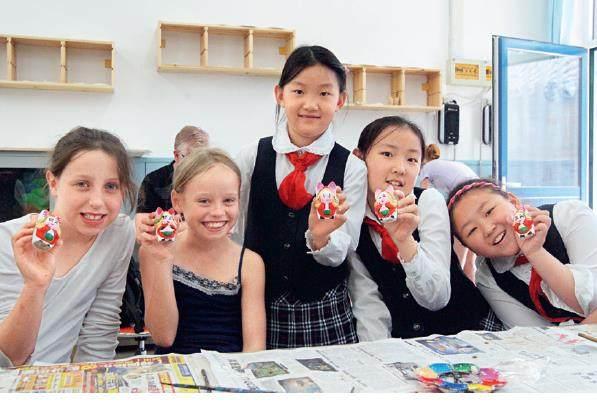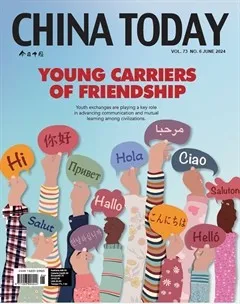Catch Them Young, Watch Them Grow
ZHOU LIN



An innovative primary school in Beijing is teachingits students humanistic literacy – how to becomeglobal citizens and understand other cultures.
“Welcome, welcome! A warm welcome!Welcome to Beijing!” A welcome chorusrang out as Brazils President Luiz InacioLula da Silva arrived at the main gate ofthe Great Hall of the People in Beijing for a meetingwith Chinese President Xi Jinping during hisstate visit to China in April 2023.
The welcome “committee” was made up ofstudents of the Beijing Shijia Hutong PrimarySchool, an 85-year-old school renowned for itsinnovative teaching methods and internationalvision. Fan Weichen was one of the students.He recalled the exciting moment: “A 21-gunsalute was fired at the Tiananmen Square, anda military band played the national anthems ofChina and Brazil. President Lula, accompaniedby President Xi, reviewed the guard of honor ofthe Chinese Peoples Liberation Army. When theypassed us, we cheered.”
Yan Xu, who organizes international exchangesat the Shijia school, said the welcome ceremonyfor visiting heads of state is one of the most importantceremonial activities during their state visits.Taking part in such an international ceremony cangive students a global vision, build their nationalidentity and national pride, and develop a sense ofbeing part of an international community. In thisway, the seed of serving as “little diplomats” can beplanted deep in their hearts.
Learning without Borders
When the school celebrated its 80th anniversaryin 2019, the principal of ?cole JeannineManuel, an international school in Paris, whichis Shijias sister school, sent a glowing tribute.Elizabeth Zeboulon, the principal, wrote, “It is agreat honor to be your sister school and share oureducational ideas. Our students are eager to visityour campus for exchanges and learning every year. The partnership between the two schoolsand even between the two countries has boostedinternational understanding, which holds incrediblesignificance.”
Founded in 1954, ?cole Jeannine Manuel is aFrench private school where Chinese is a compulsorysubject. In 2012, Shijia signed a friendlycooperation agreement with it to organizeregular cultural exchange activities, includingteacher-student visits, student homestays,teachers research and online video exchanges.The sister schools have organized many mutualvisits, giving students a chance to experiencethe cultures of China and France and deepentheir friendship.
Students from Shijia traveled to France andvisited the Louvre Museum, Palace of Versailles,Musée dOrsay, and famous chateaus. “We tookthem to see the local iconic buildings, such as theEiffel Tower, Arc de Triomphe, and Notre Dame,”Yan said. They also went on a cruise on the SeineRiver. “It gave them a panoramic view of Franceshistory and literature,” Yan said. Moreover, thestudents were taken to the tranquil and artistictown of Barbizon, where they enjoyed an immersiveexperience of French rural culture. Yan saidthe children listened attentively as the tour guidetalked about ancient European history, literature,sculpture, and art, occasionally asking questions,making it a real enjoyable learning experience.
French teachers and students also visited Shijiafor one week of learning, cultural exchanges,and family homestays. The French students experienceddifferent teaching methods and culturaldiversity. They tried their hand at traditional Chinesehandicrafts like paper quilling. The Chinesehost families treated them to Beijing roast duckand bingtang hulu or candied hawthorn sticks.They also learned how to make dumplings.
The cultural exchanges inspire young peopleto explore the diversity of cultures. Lü Zhehan,a fifth grader at Shijia, started to read Europeanhistory after his French learning partner returnedhome. Many French students spoke Chinese, English,and French, and Lü and his schoolmates areinspired to learn more foreign languages so thatthey could communicate with more young peoplefrom other countries.
Close Encounters with Chinese Culture
“Traditional Chinese culture accounts for amajor part of our international exchanges, helpingchildren understand its vastness and profoundness,”Yan said.
profoundness,”Yan said.When teachers and students of the SidwellFriends School in the United States visited Shijia,they were taken to the National Museum of Chinafor an interactive session on the origin of Chinesecharacters. They were shown prominent culturalrelics, and at the calligraphy exhibition hall, theytried to reproduce ancient Chinese writing ontiles and carvings on bones. Yan called it “an intuitiveexperience of the longhistory and culture of China.”
In the schools art class,students learned about theexquisite blue-and-white Chineseporcelain while a sportsclass taught them martialarts and etiquette, includinghumility and respect for theiropponent.
The partnership betweenthe two schools and evenbetween the two countrieshas boosted internationalunderstanding, which holdsincredible significance.
Cui Yang, vice principal of Shijia, explainedthe objective of their international understandingcourses. “Carrying forward the 5,000-yearoldChinese culture and embracing the greatcivilizations on five continents” is the originalaspiration, he told China Today . The school hasbeen building multi-level international exchangeplatforms for students so that they form a strongnational identity with a broad world vision, andgrow up into 21st century citizens with internationalliteracy.
In 2012, the school applied to the Beijing Officefor Education Sciences Planning for a researchproject, studying how to cultivate primary schoolstudents humanistic literacy through internationalexchange and cooperation. With the researchproject, the school explored ways of integratinginternational exchange and cooperationinto the schools curriculum in a systematic andsustainable way.
The school today holds three major types ofactivities. International exchanges include visitingembassies, inviting diplomats to give lectures,and organizing mutual visits to friendlyschools.
The “Borderless space for international education”program focuses on building venues both onand off campuses for learning traditional Chineseculture. Such venues include centers for learningabout the traditional Chinese musical instrumentguqin , Peking Opera, calligraphy, traditional Chinesepainting and artworks, the art of tea making,Chinese cooking, Chinese characters, bronzecasting, and woodblock printing.
The third type, curriculum for internationalunderstanding, is comprised of activities for fosteringcultural understanding, national identity,and global responsibility.
Understanding Cultural Differences
“Different understandings and coexistence” isa major topic. The school has developed a coursewith Beijing Normal University and Japan InternationalEducation Society. Called “A dialoguestarts from a bar of chocolate,” it aims to increaseChinese and Japanese primary students understandingof different cultures and their ability tocommunicate with people with different valuesand behaviors through dialogues.
Yan and a Japanese teacher from Japans MiyagiUniversity of Education Affiliated PrimarySchool created a scenario of cross-cultural conflict.Primary school students surnamed Wu andYi are friends sharing a room while traveling. Wuput a bar of chocolate on the table and went out.When he came back, the chocolate was missing.Yi told him that he had eaten it. Students areasked how they would respond if they were Wu.
They can choose from several options: A. I dontmind as we are good friends; B. I feel bad butwont let it ruin our friendship; C. I am not happyand hope it wont happen again; D. I cant understandYis behavior and will not be friends withhim anymore.
The options the Chinese and Japanese studentschose were different. Most students at ShijiaHutong Primary School chose A or B, indicatingthat they consider it acceptable for close friendsto eat their snacks without telling them. However,most Japanese students chose the last twooptions, indicating they thought it was impoliteand unacceptable to eat others snacks withoutasking them.
The teacher asked another question: “How doyou understand etiquette and friendship? Whydo we make choices so differently?” After a discussion,the students realized that they makedifferent choices because of different educationand growth environments. They also realizedthat there might be misunderstandings betweendifferent cultures, so when they encounter behaviorsthat they disagree with or cannot understand,they should rethink it from the perspectiveof that persons identity, culture, and values, andtry new ways for effective communication andmeaningful dialogue.
“It offers an opportunity for students to share their ideas,” Yan said, adding that an after-classsurvey found that students liked that class muchmore than the traditional ones, as they could saywhat they felt without the teacher overrulingthem. The innovated teaching methods and richcontents impact both the students and teachers,facilitating a more diverse way of viewingthe world, reflecting on cultural differences andultimately achieving mutual understanding.
“In todays society, cross-border and crossculturalflows have become frequent. It istherefore important for students to understandpeople of different races with different culturalbackgrounds and values through education forinternational understanding,” Cui said. “It hasbecome a basic skill for students in the era ofglobalization.”
Currently, students from Beijing Shijia HutongPrimary School are making short videos to tell thestory of the Belt and RoadInitiative, the Central Axis ofBeijing, an imaginary line connectingiconic buildings andimportant structures associatedwith state power, and“My Hometown Beijing.” Withtheir cross-cultural thinking,they hope to tell the worldgood stories of China.
The innovated teachingmethods and rich contentsimpact both the studentsand teachers, facilitatinga more diverse way ofviewing the world.

